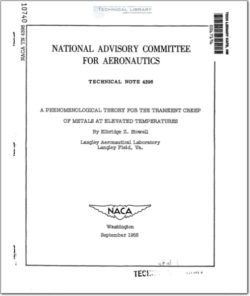NACA-TN-4396

- Version
- 160 Downloads
- 1.10 MB File Size
- 1 File Count
- March 24, 2016 Create Date
- March 24, 2016 Last Updated
National Advisory Committee for Aeronautics, Technical Notes - A Phenomenological Theory for the Transient Creep of Metal at Elevated Temperatures

The phenomenological theory previously proposed in NACA Technical
Note #000 for the behavior of metals at elevated temperatures has been
modified to yield transient creep curves by assuming that the metal con-
sists of two phases, each with its own elasticity and viscosity. The
extended theory satisfies the basic requirements for a theory of transi—
ent creep at elevated temperatures: that the transient creep be closely
connected with the subsequent steady creep, and that the apparent expo-
nent of the time in the transient region be permitted wide variations
between 0 and 1. From this theory it is possible to construct nondimen—
sional creep curves which extend continuously from the transient region
into the steady—state region. The corresponding family of creep curves
for any metal may be obtained from the nondimensional family by use of
appropriate constants. The constants required are those obtained from
steady creep measurements, together with two additional Constants which
represent the difference between the phases. The transient creep curves
resulting from this theory are compared with the experimental curves
for pure aluminum, gamma iron, lead, and 7075-T6 aluminum alloy; good
agreement is found.
In studies of the creep of metals, it has become apparent that the
creep behavior at elevated temperatures is different from that at low
temperatures. For relatively pure metals the line of demarcation occurs
at a temperature about one-half that at the melting point. In the high
temperature region it has been shown that many aspects of the elevated—
temperature behavior of some polycrystalline metals may be predicted if
certain data are available concerning their steady creep. (See ref. 1.)
The transient or primary creep which takes place before the onset
of the‘steady creep is not, however, one-of the aspects of metal behavior
which is predictable from the theory of reference 1. This transient com-
ponent of the creep could be very important in some applications. An
understanding of the nature of transient creep would be highly desirable
not only from the academic point of view but also because of the possi-
bility of predicting the magnitude of the transient creep.
| File | Action |
|---|---|
| naca-tn-4396 A Phenomenological Theory for the Transient Creep of Metal at Elevated Temperatures.pdf | Download |

Comment On This Post